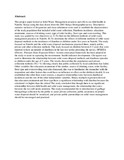| dc.description.abstract | This project paper looked at Solid Waste Management practices and effects on child health in Nairobi, Kenya using the data drawn from the 2003 Kenya Demographicsurvey. Descriptive statistics inclusive of frequencies and cross tabulations were used to establish the characteristics of the study population that included solid waste collection, Diarrhoea incidence, education attainment, sources of drinking water, type of toilet facility, floor type and overcrowding .This study was guided by two objectives i.e.
I) To find out the different methods of solid waste management practices in Nairobi.
II) To determine the effects of different methods of solid waste disposal methods to the incidences of diarrhea to children under five years in Nairobi.
The study focused on Nairobi and the solid waste disposal mechanisms practiced there, mainly public, private and other collection methods. The study focused on children between 0-5 years that were reported to have an episode of diarrhoea in the last two weeks preceding the survey.
DPSEEA (Drivers -Pressure-State-Exposure-Effect -Action) conceptual framework has been adopted in the study to assist in capturing the environment -health indicator development.
Chi square was used to determine the relationship between solid waste disposal methods and diarrhoea episodes to children under the age of 5 years. The results showed that the population used private collection methods (56.1 %) showing clearly that public collection by local authorities has failed.
Other variables like education attainment of the mother, source of drinking water, toilet facility, floor type and overcrowding were also discussed; this was to familiarize the researcher with the respondent and other factors that could have an influence or effect on the children's health. It was established that other than water sources, a negative relationship exists between diarrhoeal incidences and the rest of the other independent variables.
Binary multiple regression showed that education attainment and floor type have a significant relationship with diarrhea because the calculated t is higher than the critical The study concluded that though there is no significant relationship between child health and solid waste management, the relationship that exists between the two still needs attention. The study recommended the re-introduction of garbage bins/garbage collection by the public to assist private collection, public awareness on proper waste disposal should be sensitized, and private-public partnerships on solid waste management should be encouraged and practiced. | en_US |

